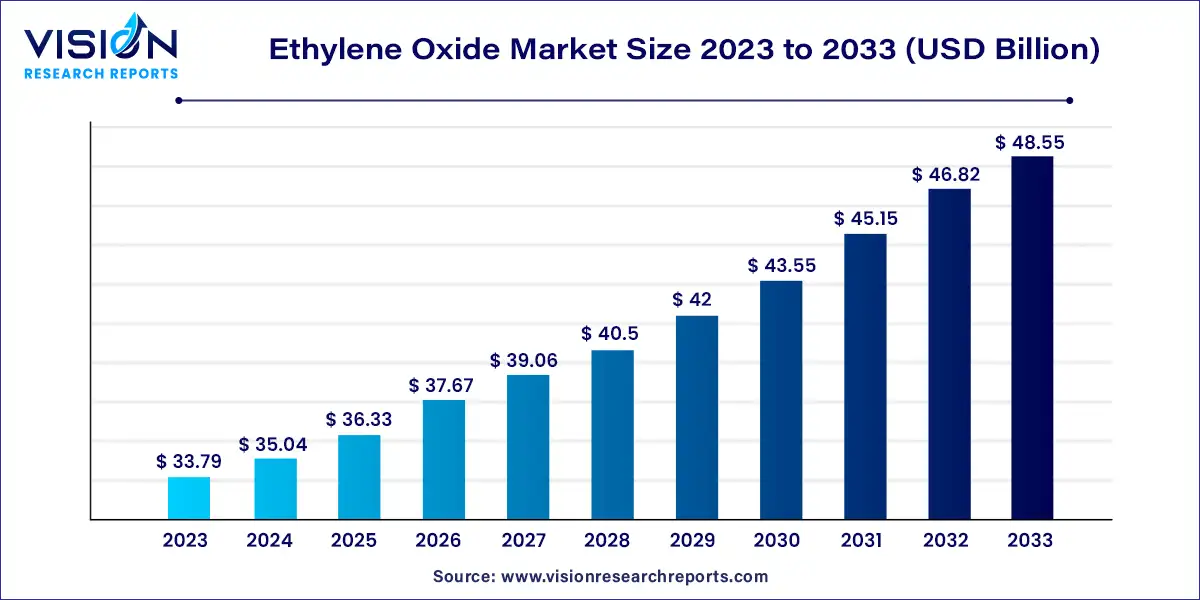The global ethylene oxide market size was estimated at around USD 33.79 billion in 2023 and it is projected to hit around USD 48.55 billion by 2033, growing at a CAGR of 3.69% from 2024 to 2033.

Ethylene oxide (EO) is a versatile and highly reactive chemical used in the production of various products, including antifreeze, detergents, and medical sterilants. It is a key intermediate in the chemical industry and plays a significant role in several industrial applications. The ethylene oxide market is a crucial component of the global chemical sector, influencing a wide range of industries.
The growth of the ethylene oxide market is primarily driven by the rising demand for ethylene glycol, a major derivative of ethylene oxide used in automotive antifreeze and industrial coolants, is a significant contributor. The automotive industry's expansion, coupled with increased vehicle production and maintenance, propels the need for ethylene glycol, thereby boosting the ethylene oxide market. Secondly, the medical sector's growing need for sterile medical devices and instruments has heightened the demand for ethylene oxide as a sterilizing agent. The prevalence of healthcare-related procedures and the rising focus on hygiene and infection control are further accelerating market growth. Additionally, the broad application of ethylene oxide in producing surfactants and detergents for both household and industrial purposes supports market expansion.
The demand for ethylene oxide has surged rapidly, driven by its diverse range of applications. This report analyzes several key uses of ethylene oxide, including monoethylene glycol, ethoxylates, ethanolamines, diethylene & triethylene glycol, polyols, and polyethylene. Monoethylene glycol is extensively used in producing films, bottles, polyester fibers, and as an antifreeze in the automotive industry. It also serves as a heat transfer fluid. In 2013, monoethylene glycol was the leading segment in the ethylene oxide market and is projected to continue growing significantly in the future. Diethylene and triethylene glycol are utilized in gas drying processes and as solvents in glue, cork, and paper products. Ethanolamine, a versatile chemical, finds applications in the textile industry, soaps, cosmetics, natural gas purification, and detergents. Polyethylene is used in pharmaceutical ointments, cosmetics, textile finishing lubricants, solvents for drugs and paints, and as plasticizers for printing inks and adhesives.
The Asia-Pacific region leads the global ethylene oxide market both in terms of volume and revenue. This growth is driven by rapid industrialization and is expected to continue over the forecast period. Following Asia-Pacific, North America holds a significant position but has experienced slower growth in recent years. Europe also faces market saturation and slower growth. In North Africa, major companies are expanding their operations to capitalize on the increasing global demand for ethylene oxide. The Asia-Pacific region, particularly the Middle East and China, is home to many leading companies driving the market forward.
By Application
By End-Use
By Region
 Cross-segment Market Size and Analysis for
Mentioned Segments
Cross-segment Market Size and Analysis for
Mentioned Segments
 Additional Company Profiles (Upto 5 With No Cost)
Additional Company Profiles (Upto 5 With No Cost)
 Additional Countries (Apart From Mentioned Countries)
Additional Countries (Apart From Mentioned Countries)
 Country/Region-specific Report
Country/Region-specific Report
 Go To Market Strategy
Go To Market Strategy
 Region Specific Market Dynamics
Region Specific Market Dynamics Region Level Market Share
Region Level Market Share Import Export Analysis
Import Export Analysis Production Analysis
Production Analysis Others
Others